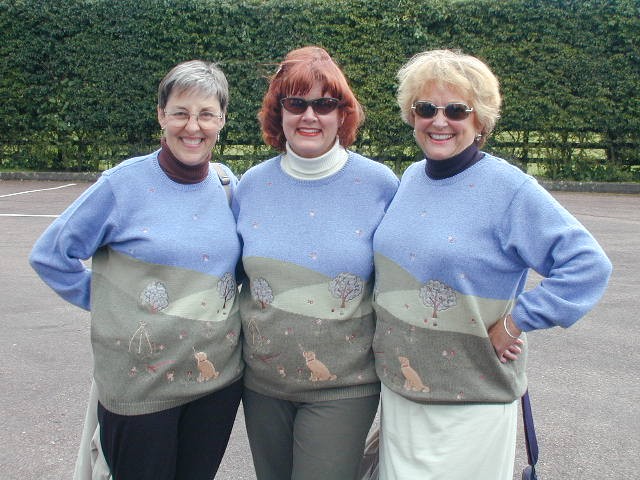

Today was the last really long driving day of our tour; we said farewell to the folks who had taken such good care of us in Dunkeld over the last four days, and headed south to York. As before, we made some interesting stops along the way. First we halted briefly at the Jedburgh Woolen Mills for snacks, restrooms and (of course) some shopping; here are Jeri Bell, Pat Edwards, and Lyn Coulter proving that "great minds think alike"!
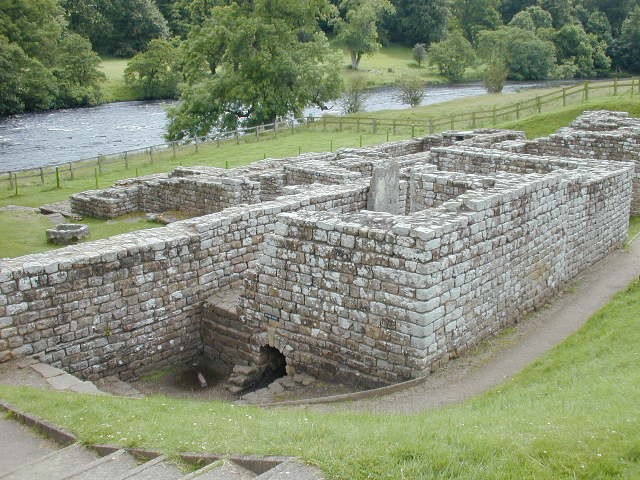
Around noon we stopped at Chesters (not the same as Chester, which we visited last Wednesday), a town near an excavation along Hadrian's Wall. This wall, which marked the northern frontier of the Roman Empire in the British Isles, was built in about six years after the Emperor Hadrian visited Britannia in 122 AD and decided something needed to be done to keep those fierce Scottish barbarians out. It runs 76 miles from the North Sea to Solway Firth, and there is a fort every mile; the one at what is now Chesters was called Cilurnum by the Romans, after the Celtic name (meaning "cauldron pool") of the location. The foundations of several major buildings, the towers, and some of the wall of the fort have been excavated; the local section of Hadrian's Wall, the bridge across the river, and the upper parts of the buildings were all long since "quarried" for building stone after the Romans departed Britain in the fifth century. The bathhouse down by the river is the best-preserved building; as with the huge complex we saw in the city of Bath, there were various baths including heated and cold ones for the soldiers to enjoy.
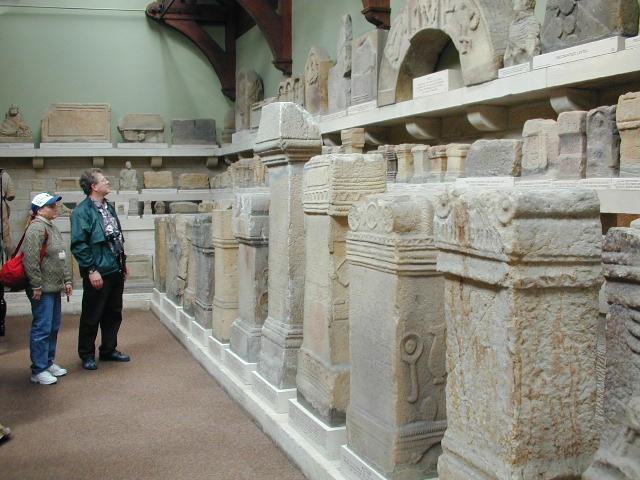
As usually seems to be the case when you're trying to visit many different places in a relatively short tour, we didn't have too much time in Chesters. But there was a museum there that showed artifacts and architectural fragments that had been dug up all along Hadrian's Wall, and some of us, like Ray and Deborah Russell here, took at least a little time to look through it.
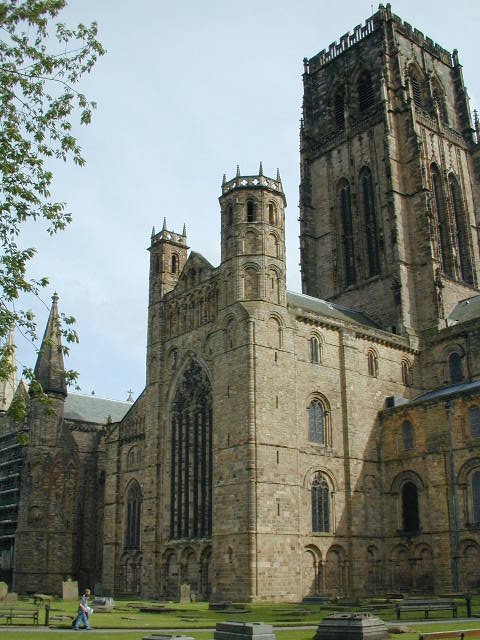
Our final stop before arriving at York was Durham, where most of us had a late lunch. Again we were running late and short on time, but nearly everyone took time to visit the town's cathedral. Unlike many cathedrals, which were build over periods of more than a century, this one was built in forty years (from 1093 to 1133) and so it doesn't have any changes in its architectural style from the oldest to the newest sections; it is all Romanesque architecture, like Westminster Abbey. It holds the tomb of the Venerable Bede, the first major English historian and biographer, who is considered "the father of English learning." Bede died in the 8th century, and his body was moved here later; the same is true of the 7th century bishop St. Cuthbert, whose body is the major religious relic in the cathedral. St. Cuthbert lived when the Roman and Celtic traditions of Christianity were being blended in Britain; the Celtic tradition, begun by St. Columba at Iona, was a fairly sparse observance, in contrast to the wealth and elaborate display that had become part of the Roman tradition. St. Cuthbert was sufficiently troubled by the opulence attending his position as a bishop that he resigned his post and went back to being a hermit monk; in keeping with his views, the interior of the cathedral where his remains are interred is sparsely decorated, which really lets you focus on the immense scale and power of the stone architecture of the building itself.
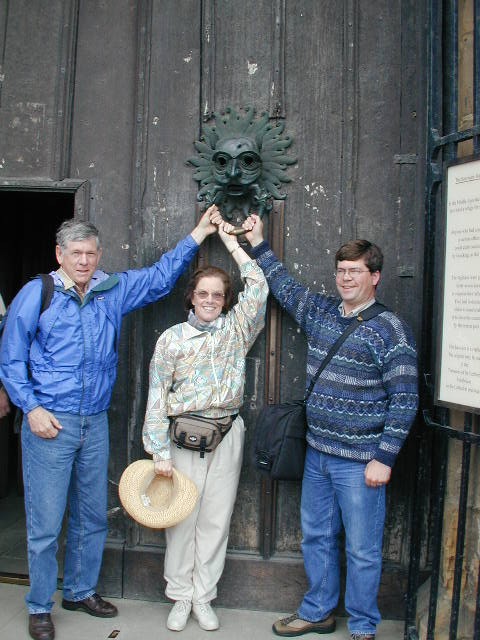
I wish very much that I could show you some of the magnificent, almost stark interior of the cathedral, but photography was not allowed inside. Outside was a different matter; here is the main door knocker (actually a replica; the original is inside in the museum, out of the elements), where somebody accused of a crime could come and knock to claim sanctuary. After sanctuary had been granted, the accused had 37 days to wrap up his affairs, after which he must either submit to trial or leave the country by the nearest port. John Mack, Evelyn Belt, and I will be gone long before our 37 days are up!
Pam Kuch and Lee Lasseter had a memorable surprise here, which I wish I'd been there to photograph. The organ was being tested and repaired, and they were up there talking to the organist when another person from the cathedral walked by and began to undo some large ropes from the wall. It turned out that he was about to ring the bells at 5 p.m., and he invited them to handle the ropes instead! They weren't able to ring them continuously until Evensong at 5:15, since that's when our buses would be leaving, so they handed the ropes back to the regular ringer; but still, what a treat!
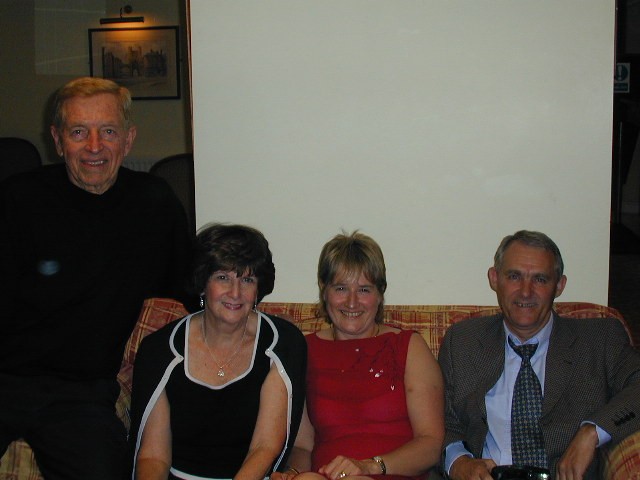
When we finally arrived in York and checked into our hotel, it was almost time for dinner in the hotel restaurant. This was uneventful, except for the fire alarm going off three times while we ate; the manager assured us that it was not the chef's cooking that was setting it off! Here are Alan and Candy Duncan with Sue and Terry Peckham, friends of theirs who had come three hours from Kidderminster to join us for dinner. Then most people went upstairs to turn in early in preparation for our full day of exploring York tomorrow!
 To
Tuesday, 9 July 2002
To
Tuesday, 9 July 2002 Back
to choir tour itinerary
Back
to choir tour itinerarynew 8 July 2002, revised 21 July 2002